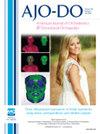Effects of orientation and postprocessing on the bonding of 3-dimensional printed brackets to printable permanent crown resin
IF 2.7
2区 医学
Q1 DENTISTRY, ORAL SURGERY & MEDICINE
American Journal of Orthodontics and Dentofacial Orthopedics
Pub Date : 2025-02-24
DOI:10.1016/j.ajodo.2024.11.009
引用次数: 0
Abstract
Introduction
This study aimed to evaluate the effects of different printing orientations and postcuring processes on the bonding performance of 3-dimensional (3D)-printed brackets to permanent crown resin.
Methods
A total of 90 disk-shaped specimens (2 mm thickness and 10 mm diameter) were manufactured from printable resin material (Formlabs Permanent Crown, Formlabs Inc, Somerville, Mass). The 3D printed brackets were fabricated at 3 build angles (0°, 45°, and 90°) with a 50 μm layer thickness. Each group consisted of 30 brackets. After printing, the postprocessing was performed either with or without glycerin immersion. Each printed resin surface and bracket base were sandblasted with 50 μm aluminum oxide particles before the bonding procedure. The 3D printed brackets were bonded with a conventional orthodontic composite resin (Transbond XT Primer, 3M Unitek, Monrovia, Calif) to printable resin surfaces. After thermal cycling, the shear bond strength (SBS) test was applied, and bonding failure was examined under a stereomicroscope at 10× magnification. Two-way analysis of variance, post-hoc Tukey, and chi-square tests were used for data analysis.
Results
Both orientation and postprocessing had significant effects on SBS. The 3D-printed brackets with 90° and glycerin immersion postcuring demonstrated the highest (13.74 ± 4.52 MPa), whereas 45° orientation without glycerin showed the lowest (7.06 ± 4.32 MPa) SBS. All specimens had cohesive-type bonding failures mainly accompanied by bracket fractures and without surface damage. The least fracture was found in 3D-printed brackets with the highest SBS.
Conclusions
The 3D printed brackets with 90° orientation and glycerin immersion postprocessing demonstrated the best bonding performance when applied to the printable permanent crown resin material.
求助全文
约1分钟内获得全文
求助全文
来源期刊
CiteScore
4.80
自引率
13.30%
发文量
432
审稿时长
66 days
期刊介绍:
Published for more than 100 years, the American Journal of Orthodontics and Dentofacial Orthopedics remains the leading orthodontic resource. It is the official publication of the American Association of Orthodontists, its constituent societies, the American Board of Orthodontics, and the College of Diplomates of the American Board of Orthodontics. Each month its readers have access to original peer-reviewed articles that examine all phases of orthodontic treatment. Illustrated throughout, the publication includes tables, color photographs, and statistical data. Coverage includes successful diagnostic procedures, imaging techniques, bracket and archwire materials, extraction and impaction concerns, orthognathic surgery, TMJ disorders, removable appliances, and adult therapy.

 求助内容:
求助内容: 应助结果提醒方式:
应助结果提醒方式:


